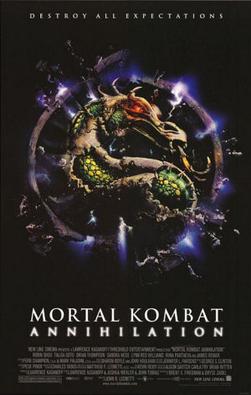Mortal Kombat Annihilation is a 1997 American martial arts fantasy film directed by John R. Leonetti in his directorial debut. Based on the Mortal Kombat video game franchise, it is the second installment in the Mortal Kombat film series and a sequel to the original 1995 film, on which Leonetti served as cinematographer.
Largely adapted from the 1995 video game Mortal Kombat 3, Annihilation follows Liu Kang and his allies as they attempt to prevent the malevolent Shao Kahn from conquering Earthrealm. It stars Robin Shou as Liu, Talisa Soto as Kitana, James Remar as Raiden, Sandra Hess as Sonya Blade, Lynn Red Williams as Jax and Brian Thompson as Kahn. Only Shou and Soto reprise their roles, with the other characters recast from the previous film.

Film Title and Release Year:
The film, titled “Mortal Kombat Annihilation,” was released in 1997. The title itself, evoking the finality of the word ‘annihilation’, was intended to bring a more intense and conclusive feel to the Mortal Kombat story arc.
Director:
John R. Leonetti, the director, was stepping into a new role, having previously been the cinematographer for the first “Mortal Kombat” film. His familiarity with the franchise’s visual elements was a critical factor in his direction of the sequel. Leonetti aimed to expand on the universe created in the first film, bringing in more characters from the games and trying to capture the essence of the Mortal Kombat universe.
Genre:
The film is a mix of martial arts, fantasy, and action. It sought to blend spectacular fight sequences with the mystical and otherworldly elements that define the Mortal Kombat universe.
Production Background:

The production of “Mortal Kombat Annihilation” faced several challenges. With a desire to include more characters and elements from the video games, the film had to balance a larger ensemble cast and more complex visual effects.
The production team worked under the pressure of high expectations following the success of the first film. They aimed to create elaborate sets and utilize special effects to bring the various realms within the Mortal Kombat universe to life.
Visual Effects and Cinematography:
The visual effects in “Mortal Kombat Annihilation” were ambitious for its time. The film used a combination of practical effects and early CGI to create the magical and supernatural elements of the story.
However, the technology of the time limited how effectively these could be realized on screen. The cinematography sought to capture the dynamic action of the games, with quick cuts and a focus on the martial arts sequences.
Storyline and Plot:

The Outworld emperor Shao Kahn opens a portal to Earthrealm and has resurrected Queen Sindel, Princess Kitana’s long-deceased mother, to facilitate his invasion.
Thunder god Raiden and Earthrealm warriors Liu Kang, Sonya Blade, and Johnny Cage try to defend themselves, but Kahn kills Cage. The Earthrealm warriors retreat to seek allies.
Sonya Blade enlists the help of her Special Forces partner, Jax, while Kitana and Liu search for a Native American shaman named Nightwolf, who seemingly knows the key to defeating Kahn. Scorpion appears and kidnaps Kitana.
Raiden meets with the Elder Gods and asks them why Kahn was allowed to break the tournament rules and force his way into Earthrealm, and how he can be stopped.
One says that reuniting Kitana with her mother, Sindel, is the key to breaking Kahn’s hold on Earthrealm, but another Elder God insists that the defeat of Kahn himself is the solution.
Raiden is then asked by the Elder Gods about his feelings and obligations towards the mortals, and what he would be willing to do to ensure their survival.

Liu finds Nightwolf, who teaches him about the power of the Animality, a form of shapeshifting which utilizes the caster’s strengths and abilities. To achieve the mindset needed to acquire this power, Liu must pass three tests.
The first is a trial of his self-esteem, courage, and focus. The second comes in the form of temptation, which manifests itself in the form of Jade, a mysterious warrior who attempts to seduce Liu and offers her assistance after he resists her advances.
Liu accepts Jade’s offer and takes her with him to the Elder Gods’ temple, where he and his friends meet with Raiden. The third test is never revealed.
The Earthrealm warriors learn that Rayden has sacrificed his immortality to freely fight alongside them. Together, they infiltrate Outworld to rescue Kitana and reunite her with Sindel in hopes of restoring her soul and closing the Outworld portal to Earth.
Liu rescues Kitana while the others incapacitate Sindel. However, Sindel remains under Kahn’s control and escapes during an ambush. Jade reveals herself to be a double agent sent by Kahn to disrupt the heroes’ plans. Kahn feeds Jade to a gargoyle for her failure.
Raiden reveals that Shao Kahn is his brother and that the former Elder God Shinnok is their father. He realizes that Shinnok is supporting Kahn. Raiden and the Earthrealm warriors make their way to Kahn, Sindel, and his remaining generals.
Shinnok demands that Raiden submit to him and restore their broken family, at the expense of his mortal friends. Raiden refuses and is killed by an energy blast from Shao Kahn.

Jax, Sonya, and Kitana emerge victorious over Kahn’s generals (with Jax defeating Motaro, Kitana defeating her mother, and Sonya defeating Ermac). Liu struggles with Kahn.
Liu’s Animality proves effective, exposing a cut to Kahn that proves he is now mortal, as a consequence of his breaking the sacred rules.
Shinnok attempts to intervene and kill Liu on Kahn’s behalf, but two of the Elder Gods arrive, having uncovered Shinnok’s treachery. They declare that the fate of Earth shall be decided in Mortal Kombat. Liu defeats Kahn, and Shinnok is banished to the Netherrealm.
Earthrealm reverts to its former state. With Kahn’s hold over Sindel broken, she reunites with Kitana. Raiden is revived by the Elder Gods, who bestow upon him his father’s former position. Before departing to the immortal realm, he enjoins the Earthrealm warriors to be there for one another. The Earthrealm warriors return home.
Character Development and Dynamics:
“Mortal Kombat Annihilation” introduced a host of new characters alongside returning favorites. However, the introduction of many characters in a limited runtime meant that character development was often sacrificed for action sequences. This impacted the depth and engagement of the character dynamics compared to the first film.

Themes:
The film continued the themes of the struggle between good and evil, the importance of teamwork, and the classic hero’s journey. It also delved into themes of loyalty, sacrifice, and destiny, which are central to the Mortal Kombat mythology.
Reception and Impact:
“Mortal Kombat Annihilation” received a predominantly negative reception from both critics and fans. The criticisms were mainly directed at the screenplay, underdeveloped characters, and the special effects, which many felt did not live up to the expectations set by the first film.
Despite its commercial performance, the film did not match the critical or fan acclaim of its predecessor and is often cited as an example of the challenges of adapting video games into movies.
Conclusion:
“Mortal Kombat Annihilation” stands as a product of its time, reflecting the challenges of late-90s special effects and the growing pains of video game adaptations. While it sought to build on the success of the first film by expanding the Mortal Kombat universe, it fell short in execution, primarily due to its ambitious scope and the limitations of the time. Despite its shortcomings, the film remains a part of the Mortal Kombat legacy and a point of reference for the evolution of video game adaptations in cinema.


 Telegram
Telegram
 Facebook
Facebook